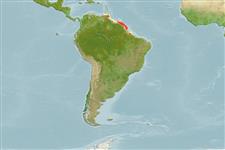>
Ophidiiformes (Cusk eels) >
Ophidiidae (Cusk-eels) > Ophidiinae
Etymology: Lepophidium: Latin, lepus, leporis = rabbit + Greek, ophis = serpent (Ref. 45335); collettei: Named for Bruce B. Collette.
Eponymy: Dr Bruce Baden Collette (d: 1934) is an American ichthyologist. [...] (Ref. 128868), visit book page.
Environment: milieu / climate zone / depth range / distribution range
Sinh thái học
Biển gần đáy; Mức độ sâu 7 - 66 m (Ref. 91765). Tropical; 12°N - 1°S, 64°W - 45°W (Ref. 91765)
Western Atlantic: Shelf waters off the mouth of the Amazon and along the Guianan coast to the Gulf of Paria between Trinidad and Venezuela.
Bộ gần gũi / Khối lượng (Trọng lượng) / Age
Maturity: Lm ? range ? - ? cm
Max length : 16.4 cm SL con đực/không giới tính; (Ref. 91765)
Short description
Khóa để định loại | Hình thái học | Sinh trắc học
Các vây lưng mềm (tổng cộng) : 116 - 122; Tia mềm vây hậu môn: 96 - 103; Động vật có xương sống: 65 - 69. This species can be distinguished from all its congeners on the basis of vertebral counts (only Lepophidium aporrhox has fewer vertebrae than L. collettei with no overlap in number of precaudal vertebrae, 14-15 vs. 12-13 in L. aporrhox). L. collettei differs further from L. aporrhox in dorsal rays (116-122 vs. 106-115), rudiments on lower gill arch (2-7 vs. 8-12), length of the long (9-11% vs. 13-18%) and short pelvic rays (5-7% vs. 8-12%) in SL; differs from L. brevibarbe in the absence of a distally expanded anterior rib in males or haltere as seen in L. brevibarbe, developed rakers on the lower gill arch (6-8 vs. 4-5), and in having a deeper body; from L. gilmorei by the average number of caeca (5.4 vs. 3.2), total gill raker elements (12-17 vs. 8-9), dorsal fin origin (between neural spines 4-5 and 5-6 vs. between 3-4); from L. marmoratum by caudal vertebrae (51-54 vs. 55-58), short pelvic rays as a percentage of standard length (5-7% vs. 8-12%), and lack of dark spots on the head and body, in rows or otherwise; from the Pacific L. microlepis by average head length (20.8% vs. 24.3% in SL) and long pelvic rays (9-11% vs. 5-8% in SL); on the basis of dorsal rays (116-122), from L. pheromystax (125-133), L. robustum (123-126), and L. stigmatistium (123-131) Ref. 91765.
Life cycle and mating behavior
Chín muồi sinh dục | Sự tái sinh sản | Đẻ trứng | Các trứng | Sự sinh sản | Ấu trùng
Robins, C.R., R.H. Robins and M.E. Brown, 2012. A revision of Lepophidium (Teleoastei, Ophidiidae), with descriptions of eight new species. Bulletin of the Florida Museum of Natural History 52(1):1-94. (Ref. 91765)
IUCN Red List Status (Ref. 130435: Version 2024-1)
Threat to humans
Harmless
Human uses
Các công cụ
Special reports
Download XML
Các nguồn internet
Estimates based on models
Preferred temperature (Ref.
123201): 26.6 - 28, mean 27.4 °C (based on 60 cells).
Phylogenetic diversity index (Ref.
82804): PD
50 = 0.5000 [Uniqueness, from 0.5 = low to 2.0 = high].
Bayesian length-weight: a=0.00102 (0.00046 - 0.00225), b=3.06 (2.88 - 3.24), in cm total length, based on all LWR estimates for this body shape (Ref.
93245).
Mức dinh dưỡng (Ref.
69278): 3.5 ±0.7 se; based on size and trophs of closest relatives
Thích nghi nhanh (Ref.
120179): Chiêù cao, thời gian nhân đôi của chủng quần tối thiểu là dưới 15 tháng (Preliminary K or Fecundity.).
Fishing Vulnerability (Ref.
59153): Low vulnerability (10 of 100).
